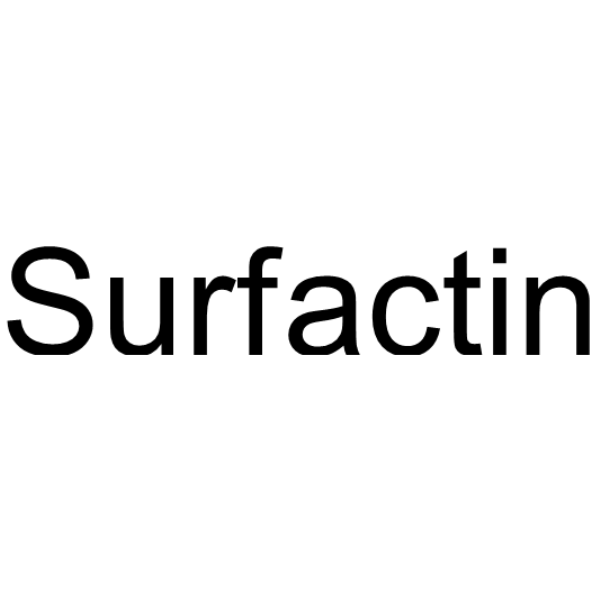Physicochemical Properties
| Molecular Formula | C53H93N7O13 |
| Molecular Weight | 1036.34463572502 |
| Exact Mass | 1035.683 |
| CAS # | 252023-70-4 |
| PubChem CID | 443592 |
| Appearance | White to off-white solid powder |
| LogP | 8.8 |
| Hydrogen Bond Donor Count | 9 |
| Hydrogen Bond Acceptor Count | 13 |
| Rotatable Bond Count | 24 |
| Heavy Atom Count | 73 |
| Complexity | 1800 |
| Defined Atom Stereocenter Count | 8 |
| SMILES | O1C([C@H](CC(C)C)NC([C@@H](CC(C)C)NC([C@H](CC(=O)O)NC([C@H](C(C)C)NC([C@@H](CC(C)C)NC([C@H](CC(C)C)NC([C@H](CCC(=O)O)NC(C[C@H]1CCCCCCCCCC(C)C)=O)=O)=O)=O)=O)=O)=O)=O |
| InChi Key | NJGWOFRZMQRKHT-WGVNQGGSSA-N |
| InChi Code | InChI=1S/C53H93N7O13/c1-30(2)20-18-16-14-13-15-17-19-21-36-28-43(61)54-37(22-23-44(62)63)47(66)55-38(24-31(3)4)48(67)57-40(26-33(7)8)51(70)60-46(35(11)12)52(71)58-41(29-45(64)65)50(69)56-39(25-32(5)6)49(68)59-42(27-34(9)10)53(72)73-36/h30-42,46H,13-29H2,1-12H3,(H,54,61)(H,55,66)(H,56,69)(H,57,67)(H,58,71)(H,59,68)(H,60,70)(H,62,63)(H,64,65)/t36-,37+,38+,39-,40-,41+,42+,46+/m1/s1 |
| Chemical Name | 3-[(3S,6R,9S,12S,15R,18S,21S,25R)-9-(carboxymethyl)-3,6,15,18-tetrakis(2-methylpropyl)-25-(10-methylundecyl)-2,5,8,11,14,17,20,23-octaoxo-12-propan-2-yl-1-oxa-4,7,10,13,16,19,22-heptazacyclopentacos-21-yl]propanoic acid |
| HS Tariff Code | 2934.99.9001 |
| Storage |
Powder-20°C 3 years 4°C 2 years In solvent -80°C 6 months -20°C 1 month |
| Shipping Condition | Room temperature (This product is stable at ambient temperature for a few days during ordinary shipping and time spent in Customs) |
Biological Activity
| Targets | Lipopeptide HSV-1 HSV-2 |
| ln Vitro | In vitro, surfactin can boost NSC277174's effectiveness against avian pathogenic Escherichia coli (APEC) using antimicrobial assays including fractional inhibitory concentration (FIC) and minimum inhibitory concentration (MIC). The minimum inhibitory concentrations of NSC277174 and surfactin for the APEC O78 strain are 1000 ug/ml and >1 mg/ml, respectively[1]. |
| ln Vivo | Surfactin and NSC277174 work together to reduce the number of deaths and liver bacterial burdens in the chick infection model (E. coli inoculation) while also controlling the expression of inflammatory cytokines and other factors. When combined with NSC277174, surfactin can function as a new antibacterial adjuvant to prevent AEPC infection in chickens[1]. |
| References |
[1]. Sensitization of avian pathogenic Escherichia coli to NSC277174 in vitro and in vivo in the presence of surfactin. PLoS One. 2019 Sep 12;14(9):e0222413. [2]. Applications of a lipopeptide biosurfactant, surfactin, produced by microorganisms. Biochemical Engineering Journal. 103 (2015) 158-169. [3]. Mechanism of inactivation of enveloped viruses by the biosurfactant surfactin from Bacillus subtilis. Biologicals. 1997 Sep;25(3):289-97. |
| Additional Infomation |
Surfactin C is a cyclodepsipeptide that is N-[(3R)-3-hydroxy-13-methyltetradecanoyl]-L-alpha-glutamyl-L-leucyl-D-leucyl-L-valyl-L-alpha-aspartyl-D-leucyl-L-leucine in which the C-terminal carboxy group has been lactonised by condensation with the alcoholic hydroxy group. It has a role as an antibacterial agent, an antifungal agent, an antiviral agent, a surfactant, a metabolite, an antineoplastic agent and a platelet aggregation inhibitor. It is a cyclodepsipeptide, a lipopeptide antibiotic and a macrocyclic lactone. Surfactin has been reported in Bacillus subtilis, Bacillus mojavensis, and Bacillus thuringiensis with data available. See also: Surfactin peptide (annotation moved to). |
Solubility Data
| Solubility (In Vitro) | DMSO : 50 mg/mL H2O : 31.25 mg/mL |
| Solubility (In Vivo) |
Solubility in Formulation 1: ≥ 2.5 mg/mL (Infinity mM) (saturation unknown) in 10% DMSO + 40% PEG300 + 5% Tween80 + 45% Saline (add these co-solvents sequentially from left to right, and one by one), clear solution. For example, if 1 mL of working solution is to be prepared, you can add 100 μL of 25.0 mg/mL clear DMSO stock solution to 400 μL PEG300 and mix evenly; then add 50 μL Tween-80 to the above solution and mix evenly; then add 450 μL normal saline to adjust the volume to 1 mL. Preparation of saline: Dissolve 0.9 g of sodium chloride in 100 mL ddH₂ O to obtain a clear solution. Solubility in Formulation 2: ≥ 2.5 mg/mL (Infinity mM) (saturation unknown) in 10% DMSO + 90% (20% SBE-β-CD in Saline) (add these co-solvents sequentially from left to right, and one by one), clear solution. For example, if 1 mL of working solution is to be prepared, you can add 100 μL of 25.0 mg/mL clear DMSO stock solution to 900 μL of 20% SBE-β-CD physiological saline solution and mix evenly. Preparation of 20% SBE-β-CD in Saline (4°C,1 week): Dissolve 2 g SBE-β-CD in 10 mL saline to obtain a clear solution. Solubility in Formulation 3: ≥ 2.5 mg/mL (Infinity mM) (saturation unknown) in 10% DMSO + 90% Corn Oil (add these co-solvents sequentially from left to right, and one by one), clear solution. For example, if 1 mL of working solution is to be prepared, you can add 100 μL of 25.0 mg/mL clear DMSO stock solution to 900 μL of corn oil and mix evenly. Solubility in Formulation 4: 110 mg/mL (Infinity mM) in PBS (add these co-solvents sequentially from left to right, and one by one), clear solution; with ultrasonication. (Please use freshly prepared in vivo formulations for optimal results.) |
| Preparing Stock Solutions | 1 mg | 5 mg | 10 mg | |
| 1 mM | 0.9649 mL | 4.8246 mL | 9.6492 mL | |
| 5 mM | 0.1930 mL | 0.9649 mL | 1.9298 mL | |
| 10 mM | 0.0965 mL | 0.4825 mL | 0.9649 mL |
